HA3042 Taxation Law Assignment: Fringe Benefits Tax and CGT Analysis
VerifiedAdded on 2022/11/24
|9
|2279
|418
Homework Assignment
AI Summary
This document presents a detailed solution to a Taxation Law assignment, addressing two key areas: Fringe Benefits Tax (FBT) and Capital Gains Tax (CGT). The FBT section analyzes a car fringe benefit, calculating the taxable value using both the statutory formula method and the operating cost method, comparing the outcomes to determine the most advantageous approach. The CGT section provides an in-depth analysis of various capital gains events, including the sale of a house, an artistic painting, a luxury yacht, and shares in a mining company. It calculates capital gains or losses for each asset, considering relevant cost bases, capital proceeds, and the impact of primary place of residence exemptions. The document also addresses the treatment of capital losses and their potential to offset capital gains in the current and future tax years, concluding with the integration of capital gains into assessable income and the application of tax slabs.
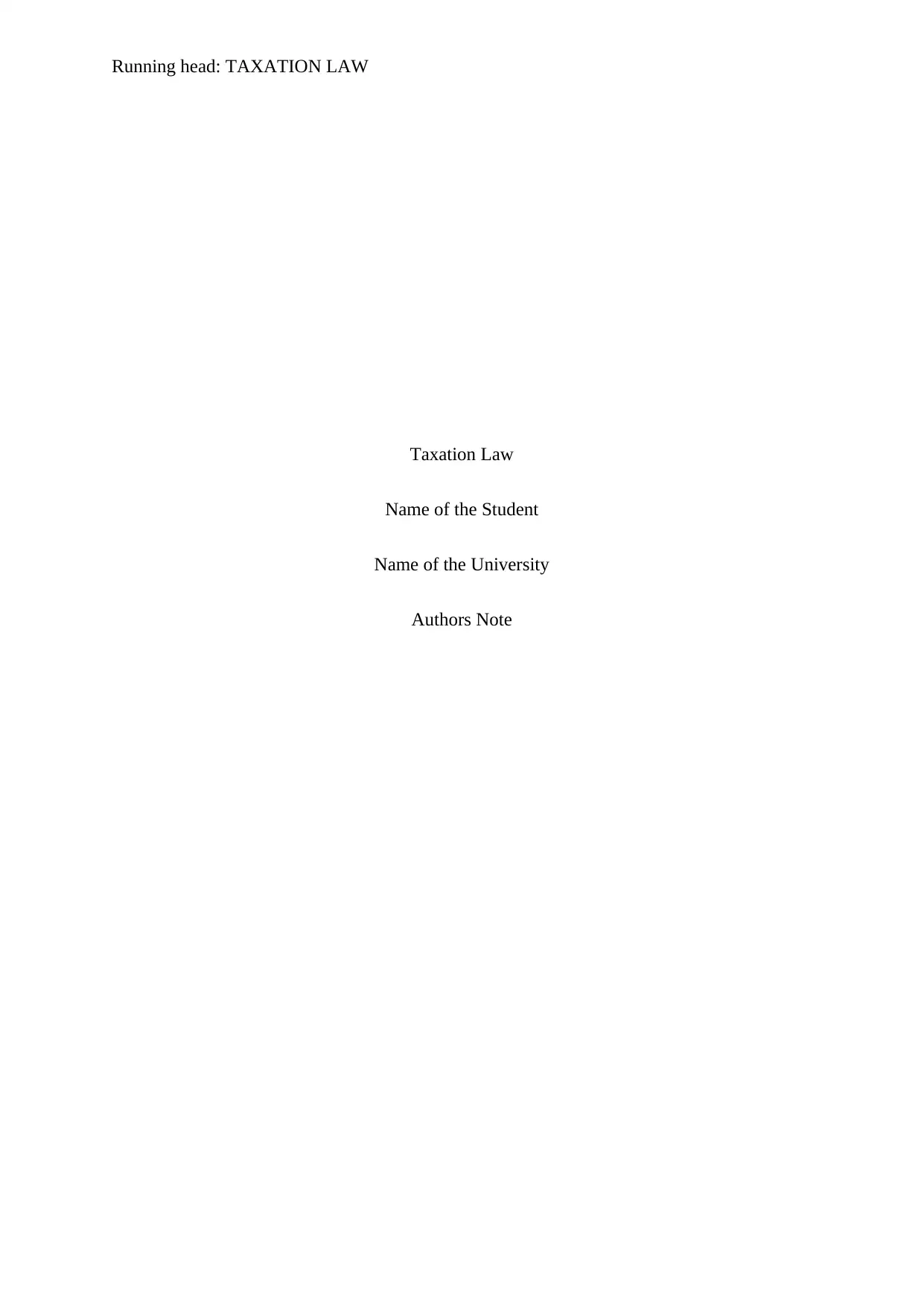
Running head: TAXATION LAW
Taxation Law
Name of the Student
Name of the University
Authors Note
Taxation Law
Name of the Student
Name of the University
Authors Note
Paraphrase This Document
Need a fresh take? Get an instant paraphrase of this document with our AI Paraphraser
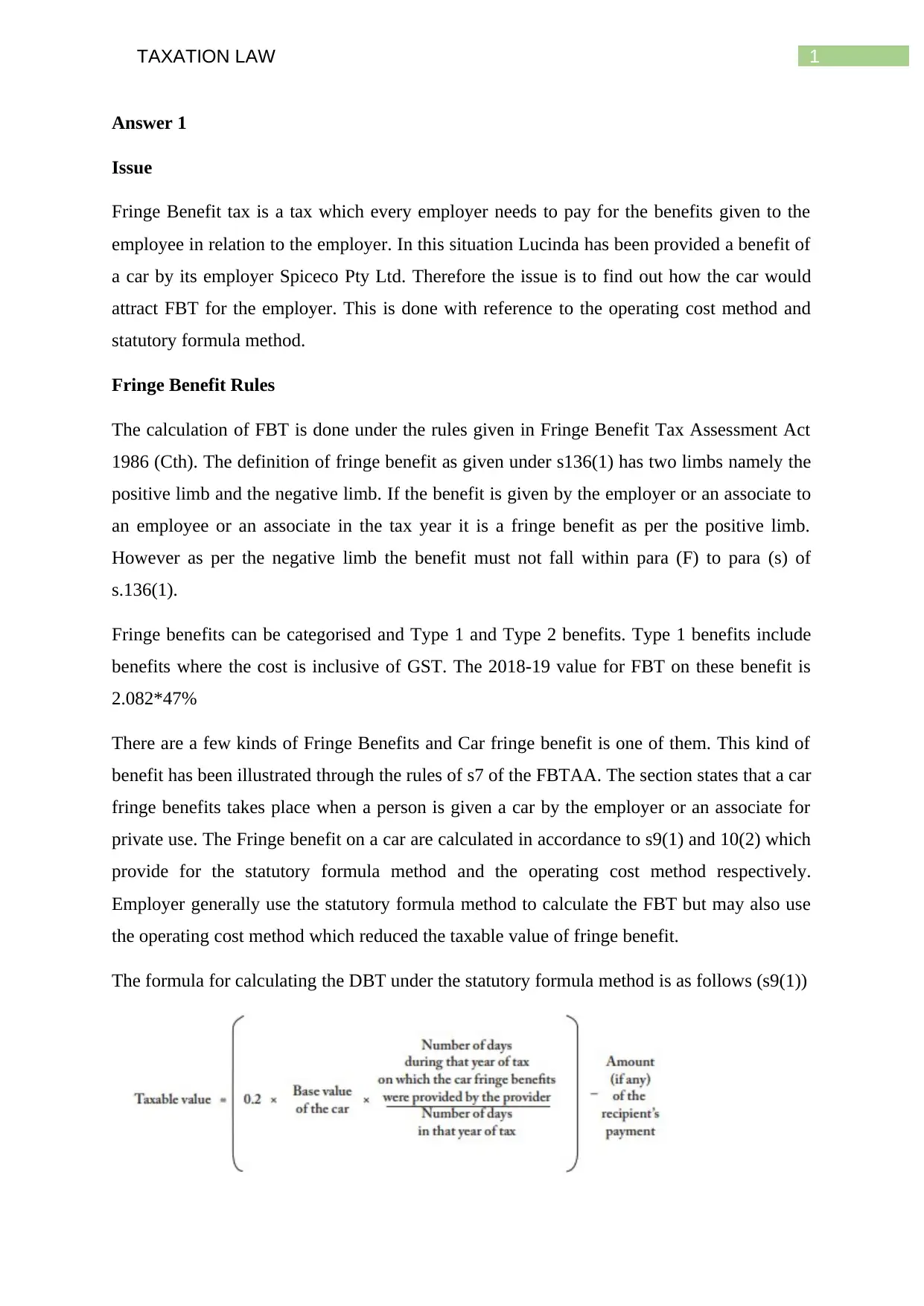
1TAXATION LAW
Answer 1
Issue
Fringe Benefit tax is a tax which every employer needs to pay for the benefits given to the
employee in relation to the employer. In this situation Lucinda has been provided a benefit of
a car by its employer Spiceco Pty Ltd. Therefore the issue is to find out how the car would
attract FBT for the employer. This is done with reference to the operating cost method and
statutory formula method.
Fringe Benefit Rules
The calculation of FBT is done under the rules given in Fringe Benefit Tax Assessment Act
1986 (Cth). The definition of fringe benefit as given under s136(1) has two limbs namely the
positive limb and the negative limb. If the benefit is given by the employer or an associate to
an employee or an associate in the tax year it is a fringe benefit as per the positive limb.
However as per the negative limb the benefit must not fall within para (F) to para (s) of
s.136(1).
Fringe benefits can be categorised and Type 1 and Type 2 benefits. Type 1 benefits include
benefits where the cost is inclusive of GST. The 2018-19 value for FBT on these benefit is
2.082*47%
There are a few kinds of Fringe Benefits and Car fringe benefit is one of them. This kind of
benefit has been illustrated through the rules of s7 of the FBTAA. The section states that a car
fringe benefits takes place when a person is given a car by the employer or an associate for
private use. The Fringe benefit on a car are calculated in accordance to s9(1) and 10(2) which
provide for the statutory formula method and the operating cost method respectively.
Employer generally use the statutory formula method to calculate the FBT but may also use
the operating cost method which reduced the taxable value of fringe benefit.
The formula for calculating the DBT under the statutory formula method is as follows (s9(1))
Answer 1
Issue
Fringe Benefit tax is a tax which every employer needs to pay for the benefits given to the
employee in relation to the employer. In this situation Lucinda has been provided a benefit of
a car by its employer Spiceco Pty Ltd. Therefore the issue is to find out how the car would
attract FBT for the employer. This is done with reference to the operating cost method and
statutory formula method.
Fringe Benefit Rules
The calculation of FBT is done under the rules given in Fringe Benefit Tax Assessment Act
1986 (Cth). The definition of fringe benefit as given under s136(1) has two limbs namely the
positive limb and the negative limb. If the benefit is given by the employer or an associate to
an employee or an associate in the tax year it is a fringe benefit as per the positive limb.
However as per the negative limb the benefit must not fall within para (F) to para (s) of
s.136(1).
Fringe benefits can be categorised and Type 1 and Type 2 benefits. Type 1 benefits include
benefits where the cost is inclusive of GST. The 2018-19 value for FBT on these benefit is
2.082*47%
There are a few kinds of Fringe Benefits and Car fringe benefit is one of them. This kind of
benefit has been illustrated through the rules of s7 of the FBTAA. The section states that a car
fringe benefits takes place when a person is given a car by the employer or an associate for
private use. The Fringe benefit on a car are calculated in accordance to s9(1) and 10(2) which
provide for the statutory formula method and the operating cost method respectively.
Employer generally use the statutory formula method to calculate the FBT but may also use
the operating cost method which reduced the taxable value of fringe benefit.
The formula for calculating the DBT under the statutory formula method is as follows (s9(1))
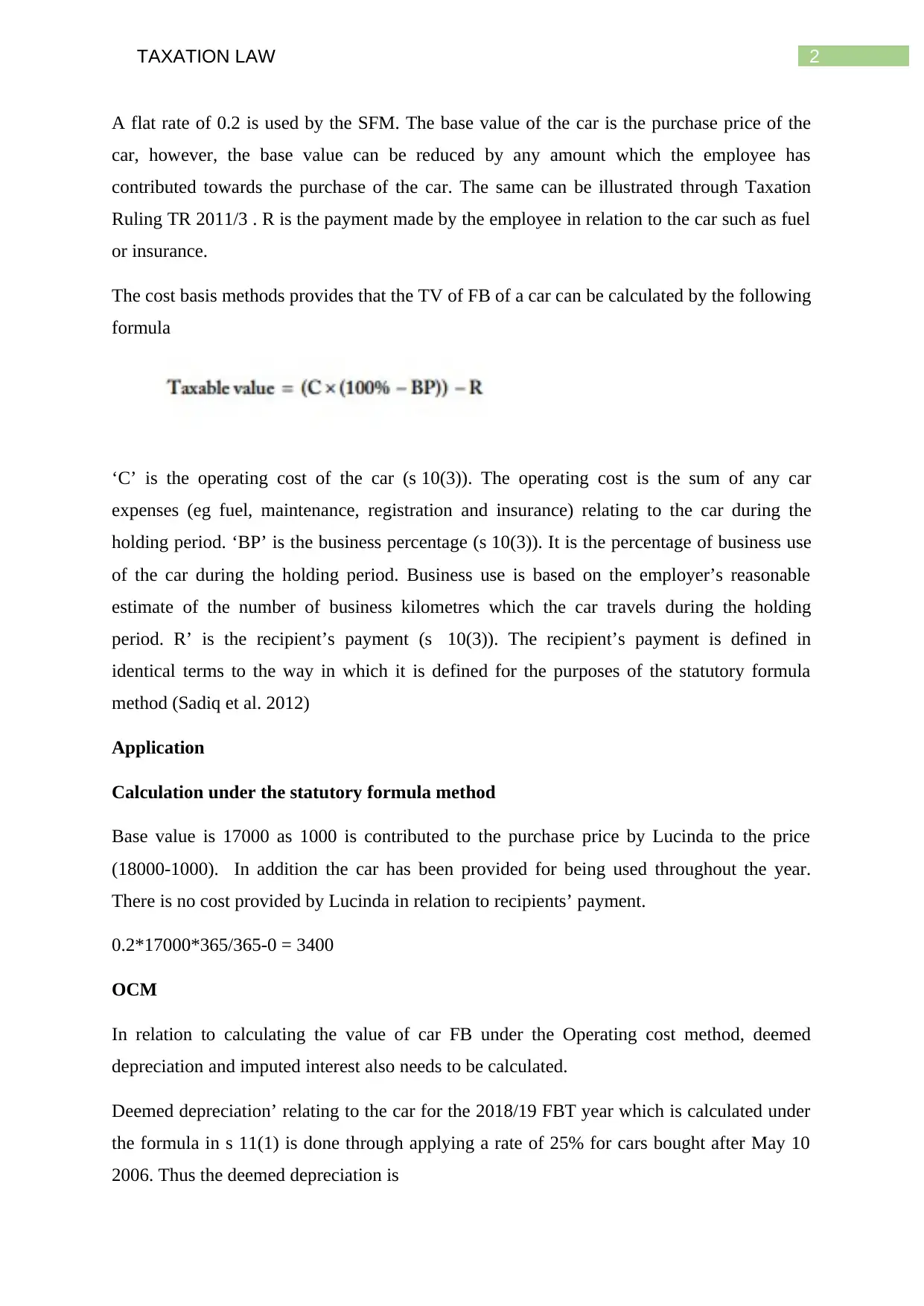
2TAXATION LAW
A flat rate of 0.2 is used by the SFM. The base value of the car is the purchase price of the
car, however, the base value can be reduced by any amount which the employee has
contributed towards the purchase of the car. The same can be illustrated through Taxation
Ruling TR 2011/3 . R is the payment made by the employee in relation to the car such as fuel
or insurance.
The cost basis methods provides that the TV of FB of a car can be calculated by the following
formula
‘C’ is the operating cost of the car (s 10(3)). The operating cost is the sum of any car
expenses (eg fuel, maintenance, registration and insurance) relating to the car during the
holding period. ‘BP’ is the business percentage (s 10(3)). It is the percentage of business use
of the car during the holding period. Business use is based on the employer’s reasonable
estimate of the number of business kilometres which the car travels during the holding
period. R’ is the recipient’s payment (s 10(3)). The recipient’s payment is defined in
identical terms to the way in which it is defined for the purposes of the statutory formula
method (Sadiq et al. 2012)
Application
Calculation under the statutory formula method
Base value is 17000 as 1000 is contributed to the purchase price by Lucinda to the price
(18000-1000). In addition the car has been provided for being used throughout the year.
There is no cost provided by Lucinda in relation to recipients’ payment.
0.2*17000*365/365-0 = 3400
OCM
In relation to calculating the value of car FB under the Operating cost method, deemed
depreciation and imputed interest also needs to be calculated.
Deemed depreciation’ relating to the car for the 2018/19 FBT year which is calculated under
the formula in s 11(1) is done through applying a rate of 25% for cars bought after May 10
2006. Thus the deemed depreciation is
A flat rate of 0.2 is used by the SFM. The base value of the car is the purchase price of the
car, however, the base value can be reduced by any amount which the employee has
contributed towards the purchase of the car. The same can be illustrated through Taxation
Ruling TR 2011/3 . R is the payment made by the employee in relation to the car such as fuel
or insurance.
The cost basis methods provides that the TV of FB of a car can be calculated by the following
formula
‘C’ is the operating cost of the car (s 10(3)). The operating cost is the sum of any car
expenses (eg fuel, maintenance, registration and insurance) relating to the car during the
holding period. ‘BP’ is the business percentage (s 10(3)). It is the percentage of business use
of the car during the holding period. Business use is based on the employer’s reasonable
estimate of the number of business kilometres which the car travels during the holding
period. R’ is the recipient’s payment (s 10(3)). The recipient’s payment is defined in
identical terms to the way in which it is defined for the purposes of the statutory formula
method (Sadiq et al. 2012)
Application
Calculation under the statutory formula method
Base value is 17000 as 1000 is contributed to the purchase price by Lucinda to the price
(18000-1000). In addition the car has been provided for being used throughout the year.
There is no cost provided by Lucinda in relation to recipients’ payment.
0.2*17000*365/365-0 = 3400
OCM
In relation to calculating the value of car FB under the Operating cost method, deemed
depreciation and imputed interest also needs to be calculated.
Deemed depreciation’ relating to the car for the 2018/19 FBT year which is calculated under
the formula in s 11(1) is done through applying a rate of 25% for cars bought after May 10
2006. Thus the deemed depreciation is
⊘ This is a preview!⊘
Do you want full access?
Subscribe today to unlock all pages.

Trusted by 1+ million students worldwide
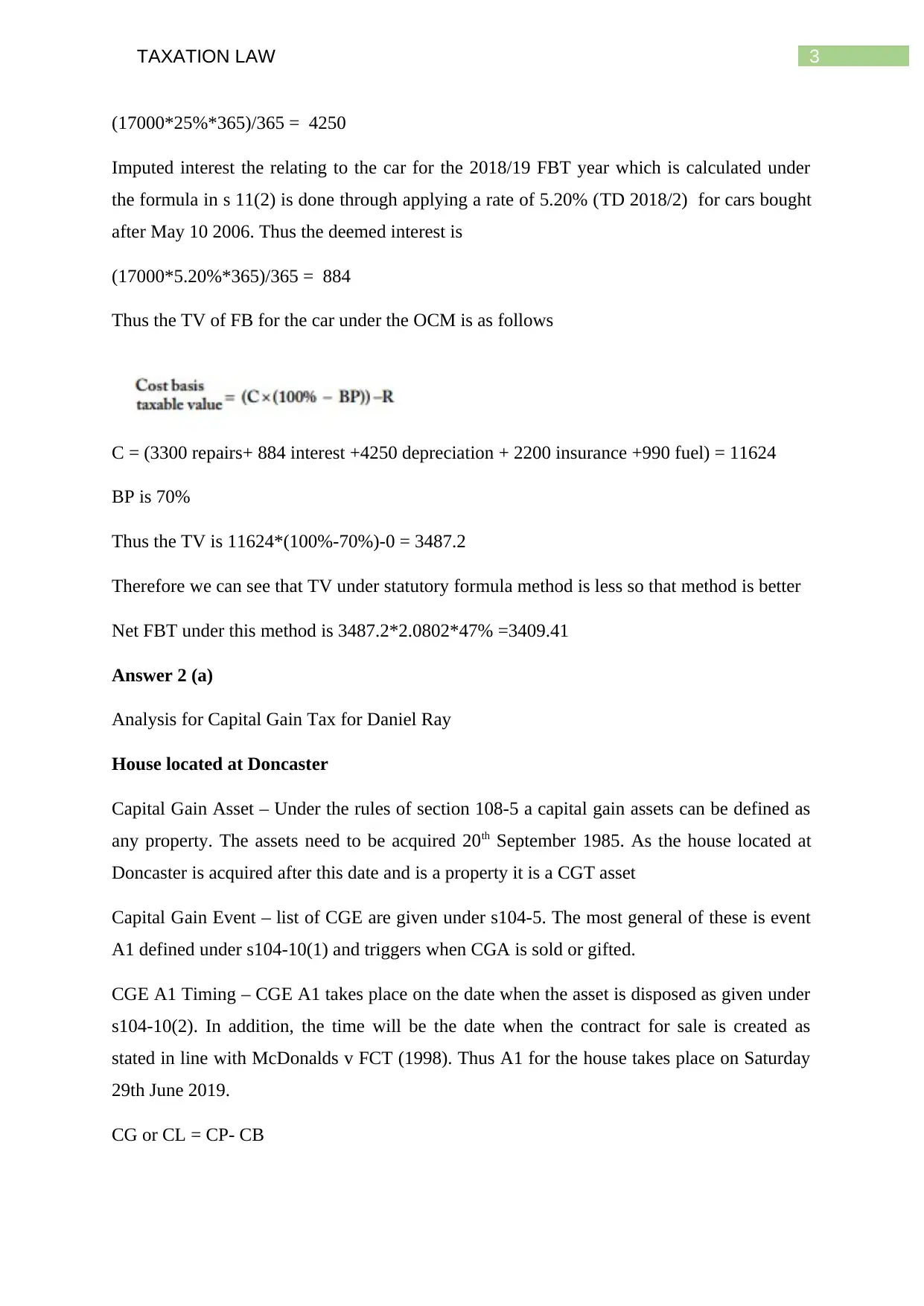
3TAXATION LAW
(17000*25%*365)/365 = 4250
Imputed interest the relating to the car for the 2018/19 FBT year which is calculated under
the formula in s 11(2) is done through applying a rate of 5.20% (TD 2018/2) for cars bought
after May 10 2006. Thus the deemed interest is
(17000*5.20%*365)/365 = 884
Thus the TV of FB for the car under the OCM is as follows
C = (3300 repairs+ 884 interest +4250 depreciation + 2200 insurance +990 fuel) = 11624
BP is 70%
Thus the TV is 11624*(100%-70%)-0 = 3487.2
Therefore we can see that TV under statutory formula method is less so that method is better
Net FBT under this method is 3487.2*2.0802*47% =3409.41
Answer 2 (a)
Analysis for Capital Gain Tax for Daniel Ray
House located at Doncaster
Capital Gain Asset – Under the rules of section 108-5 a capital gain assets can be defined as
any property. The assets need to be acquired 20th September 1985. As the house located at
Doncaster is acquired after this date and is a property it is a CGT asset
Capital Gain Event – list of CGE are given under s104-5. The most general of these is event
A1 defined under s104-10(1) and triggers when CGA is sold or gifted.
CGE A1 Timing – CGE A1 takes place on the date when the asset is disposed as given under
s104-10(2). In addition, the time will be the date when the contract for sale is created as
stated in line with McDonalds v FCT (1998). Thus A1 for the house takes place on Saturday
29th June 2019.
CG or CL = CP- CB
(17000*25%*365)/365 = 4250
Imputed interest the relating to the car for the 2018/19 FBT year which is calculated under
the formula in s 11(2) is done through applying a rate of 5.20% (TD 2018/2) for cars bought
after May 10 2006. Thus the deemed interest is
(17000*5.20%*365)/365 = 884
Thus the TV of FB for the car under the OCM is as follows
C = (3300 repairs+ 884 interest +4250 depreciation + 2200 insurance +990 fuel) = 11624
BP is 70%
Thus the TV is 11624*(100%-70%)-0 = 3487.2
Therefore we can see that TV under statutory formula method is less so that method is better
Net FBT under this method is 3487.2*2.0802*47% =3409.41
Answer 2 (a)
Analysis for Capital Gain Tax for Daniel Ray
House located at Doncaster
Capital Gain Asset – Under the rules of section 108-5 a capital gain assets can be defined as
any property. The assets need to be acquired 20th September 1985. As the house located at
Doncaster is acquired after this date and is a property it is a CGT asset
Capital Gain Event – list of CGE are given under s104-5. The most general of these is event
A1 defined under s104-10(1) and triggers when CGA is sold or gifted.
CGE A1 Timing – CGE A1 takes place on the date when the asset is disposed as given under
s104-10(2). In addition, the time will be the date when the contract for sale is created as
stated in line with McDonalds v FCT (1998). Thus A1 for the house takes place on Saturday
29th June 2019.
CG or CL = CP- CB
Paraphrase This Document
Need a fresh take? Get an instant paraphrase of this document with our AI Paraphraser
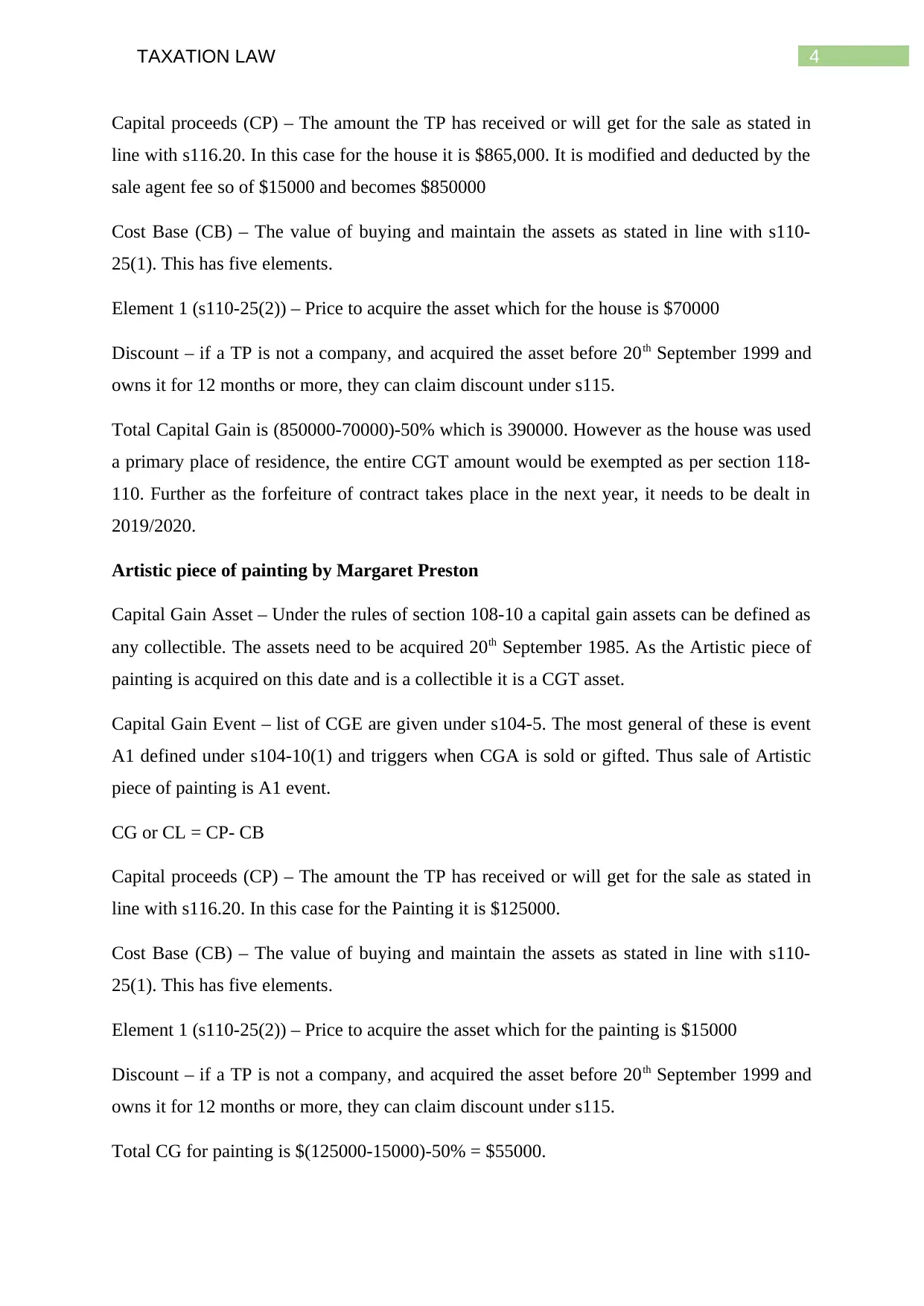
4TAXATION LAW
Capital proceeds (CP) – The amount the TP has received or will get for the sale as stated in
line with s116.20. In this case for the house it is $865,000. It is modified and deducted by the
sale agent fee so of $15000 and becomes $850000
Cost Base (CB) – The value of buying and maintain the assets as stated in line with s110-
25(1). This has five elements.
Element 1 (s110-25(2)) – Price to acquire the asset which for the house is $70000
Discount – if a TP is not a company, and acquired the asset before 20th September 1999 and
owns it for 12 months or more, they can claim discount under s115.
Total Capital Gain is (850000-70000)-50% which is 390000. However as the house was used
a primary place of residence, the entire CGT amount would be exempted as per section 118-
110. Further as the forfeiture of contract takes place in the next year, it needs to be dealt in
2019/2020.
Artistic piece of painting by Margaret Preston
Capital Gain Asset – Under the rules of section 108-10 a capital gain assets can be defined as
any collectible. The assets need to be acquired 20th September 1985. As the Artistic piece of
painting is acquired on this date and is a collectible it is a CGT asset.
Capital Gain Event – list of CGE are given under s104-5. The most general of these is event
A1 defined under s104-10(1) and triggers when CGA is sold or gifted. Thus sale of Artistic
piece of painting is A1 event.
CG or CL = CP- CB
Capital proceeds (CP) – The amount the TP has received or will get for the sale as stated in
line with s116.20. In this case for the Painting it is $125000.
Cost Base (CB) – The value of buying and maintain the assets as stated in line with s110-
25(1). This has five elements.
Element 1 (s110-25(2)) – Price to acquire the asset which for the painting is $15000
Discount – if a TP is not a company, and acquired the asset before 20th September 1999 and
owns it for 12 months or more, they can claim discount under s115.
Total CG for painting is $(125000-15000)-50% = $55000.
Capital proceeds (CP) – The amount the TP has received or will get for the sale as stated in
line with s116.20. In this case for the house it is $865,000. It is modified and deducted by the
sale agent fee so of $15000 and becomes $850000
Cost Base (CB) – The value of buying and maintain the assets as stated in line with s110-
25(1). This has five elements.
Element 1 (s110-25(2)) – Price to acquire the asset which for the house is $70000
Discount – if a TP is not a company, and acquired the asset before 20th September 1999 and
owns it for 12 months or more, they can claim discount under s115.
Total Capital Gain is (850000-70000)-50% which is 390000. However as the house was used
a primary place of residence, the entire CGT amount would be exempted as per section 118-
110. Further as the forfeiture of contract takes place in the next year, it needs to be dealt in
2019/2020.
Artistic piece of painting by Margaret Preston
Capital Gain Asset – Under the rules of section 108-10 a capital gain assets can be defined as
any collectible. The assets need to be acquired 20th September 1985. As the Artistic piece of
painting is acquired on this date and is a collectible it is a CGT asset.
Capital Gain Event – list of CGE are given under s104-5. The most general of these is event
A1 defined under s104-10(1) and triggers when CGA is sold or gifted. Thus sale of Artistic
piece of painting is A1 event.
CG or CL = CP- CB
Capital proceeds (CP) – The amount the TP has received or will get for the sale as stated in
line with s116.20. In this case for the Painting it is $125000.
Cost Base (CB) – The value of buying and maintain the assets as stated in line with s110-
25(1). This has five elements.
Element 1 (s110-25(2)) – Price to acquire the asset which for the painting is $15000
Discount – if a TP is not a company, and acquired the asset before 20th September 1999 and
owns it for 12 months or more, they can claim discount under s115.
Total CG for painting is $(125000-15000)-50% = $55000.
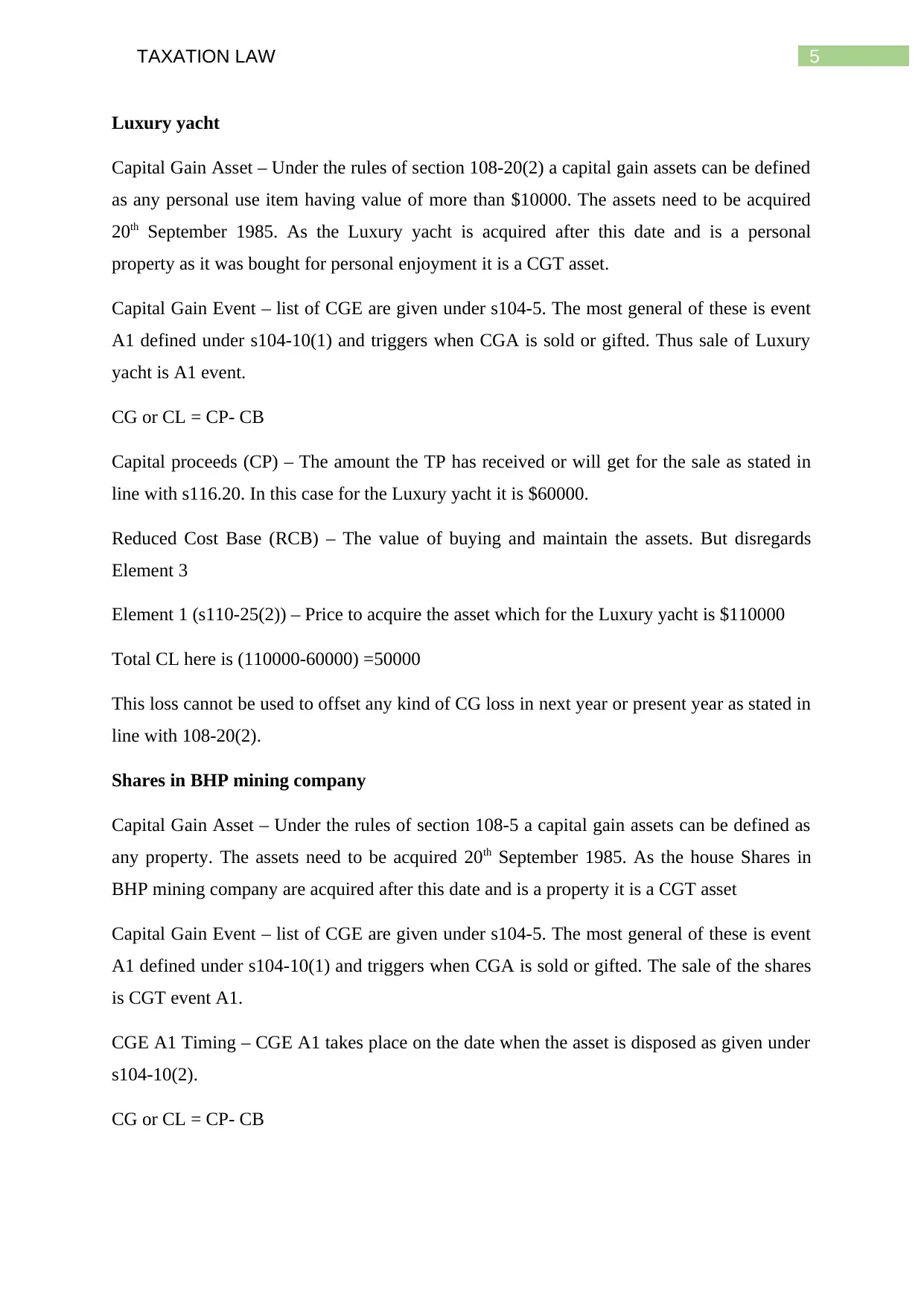
5TAXATION LAW
Luxury yacht
Capital Gain Asset – Under the rules of section 108-20(2) a capital gain assets can be defined
as any personal use item having value of more than $10000. The assets need to be acquired
20th September 1985. As the Luxury yacht is acquired after this date and is a personal
property as it was bought for personal enjoyment it is a CGT asset.
Capital Gain Event – list of CGE are given under s104-5. The most general of these is event
A1 defined under s104-10(1) and triggers when CGA is sold or gifted. Thus sale of Luxury
yacht is A1 event.
CG or CL = CP- CB
Capital proceeds (CP) – The amount the TP has received or will get for the sale as stated in
line with s116.20. In this case for the Luxury yacht it is $60000.
Reduced Cost Base (RCB) – The value of buying and maintain the assets. But disregards
Element 3
Element 1 (s110-25(2)) – Price to acquire the asset which for the Luxury yacht is $110000
Total CL here is (110000-60000) =50000
This loss cannot be used to offset any kind of CG loss in next year or present year as stated in
line with 108-20(2).
Shares in BHP mining company
Capital Gain Asset – Under the rules of section 108-5 a capital gain assets can be defined as
any property. The assets need to be acquired 20th September 1985. As the house Shares in
BHP mining company are acquired after this date and is a property it is a CGT asset
Capital Gain Event – list of CGE are given under s104-5. The most general of these is event
A1 defined under s104-10(1) and triggers when CGA is sold or gifted. The sale of the shares
is CGT event A1.
CGE A1 Timing – CGE A1 takes place on the date when the asset is disposed as given under
s104-10(2).
CG or CL = CP- CB
Luxury yacht
Capital Gain Asset – Under the rules of section 108-20(2) a capital gain assets can be defined
as any personal use item having value of more than $10000. The assets need to be acquired
20th September 1985. As the Luxury yacht is acquired after this date and is a personal
property as it was bought for personal enjoyment it is a CGT asset.
Capital Gain Event – list of CGE are given under s104-5. The most general of these is event
A1 defined under s104-10(1) and triggers when CGA is sold or gifted. Thus sale of Luxury
yacht is A1 event.
CG or CL = CP- CB
Capital proceeds (CP) – The amount the TP has received or will get for the sale as stated in
line with s116.20. In this case for the Luxury yacht it is $60000.
Reduced Cost Base (RCB) – The value of buying and maintain the assets. But disregards
Element 3
Element 1 (s110-25(2)) – Price to acquire the asset which for the Luxury yacht is $110000
Total CL here is (110000-60000) =50000
This loss cannot be used to offset any kind of CG loss in next year or present year as stated in
line with 108-20(2).
Shares in BHP mining company
Capital Gain Asset – Under the rules of section 108-5 a capital gain assets can be defined as
any property. The assets need to be acquired 20th September 1985. As the house Shares in
BHP mining company are acquired after this date and is a property it is a CGT asset
Capital Gain Event – list of CGE are given under s104-5. The most general of these is event
A1 defined under s104-10(1) and triggers when CGA is sold or gifted. The sale of the shares
is CGT event A1.
CGE A1 Timing – CGE A1 takes place on the date when the asset is disposed as given under
s104-10(2).
CG or CL = CP- CB
⊘ This is a preview!⊘
Do you want full access?
Subscribe today to unlock all pages.

Trusted by 1+ million students worldwide
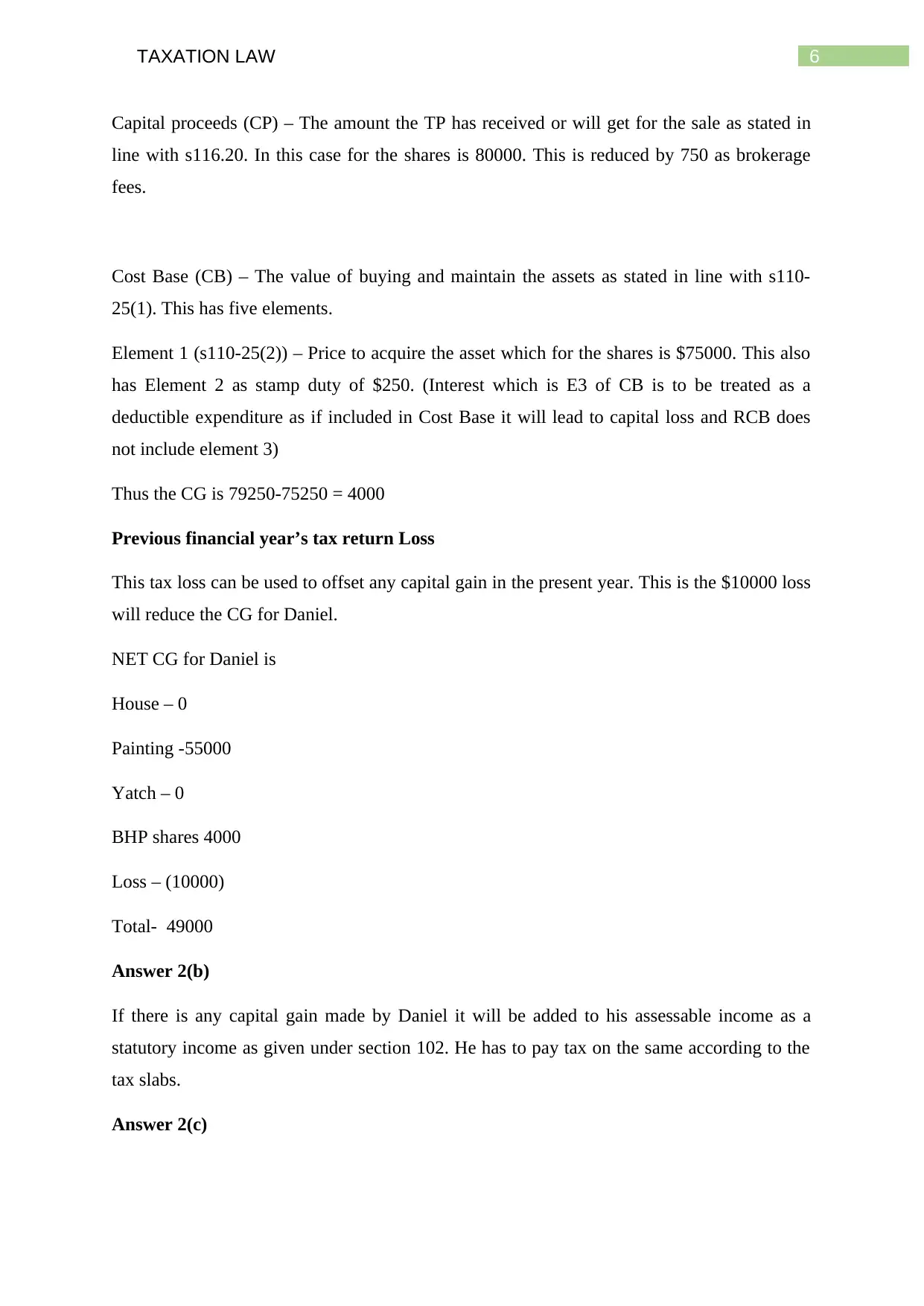
6TAXATION LAW
Capital proceeds (CP) – The amount the TP has received or will get for the sale as stated in
line with s116.20. In this case for the shares is 80000. This is reduced by 750 as brokerage
fees.
Cost Base (CB) – The value of buying and maintain the assets as stated in line with s110-
25(1). This has five elements.
Element 1 (s110-25(2)) – Price to acquire the asset which for the shares is $75000. This also
has Element 2 as stamp duty of $250. (Interest which is E3 of CB is to be treated as a
deductible expenditure as if included in Cost Base it will lead to capital loss and RCB does
not include element 3)
Thus the CG is 79250-75250 = 4000
Previous financial year’s tax return Loss
This tax loss can be used to offset any capital gain in the present year. This is the $10000 loss
will reduce the CG for Daniel.
NET CG for Daniel is
House – 0
Painting -55000
Yatch – 0
BHP shares 4000
Loss – (10000)
Total- 49000
Answer 2(b)
If there is any capital gain made by Daniel it will be added to his assessable income as a
statutory income as given under section 102. He has to pay tax on the same according to the
tax slabs.
Answer 2(c)
Capital proceeds (CP) – The amount the TP has received or will get for the sale as stated in
line with s116.20. In this case for the shares is 80000. This is reduced by 750 as brokerage
fees.
Cost Base (CB) – The value of buying and maintain the assets as stated in line with s110-
25(1). This has five elements.
Element 1 (s110-25(2)) – Price to acquire the asset which for the shares is $75000. This also
has Element 2 as stamp duty of $250. (Interest which is E3 of CB is to be treated as a
deductible expenditure as if included in Cost Base it will lead to capital loss and RCB does
not include element 3)
Thus the CG is 79250-75250 = 4000
Previous financial year’s tax return Loss
This tax loss can be used to offset any capital gain in the present year. This is the $10000 loss
will reduce the CG for Daniel.
NET CG for Daniel is
House – 0
Painting -55000
Yatch – 0
BHP shares 4000
Loss – (10000)
Total- 49000
Answer 2(b)
If there is any capital gain made by Daniel it will be added to his assessable income as a
statutory income as given under section 102. He has to pay tax on the same according to the
tax slabs.
Answer 2(c)
Paraphrase This Document
Need a fresh take? Get an instant paraphrase of this document with our AI Paraphraser
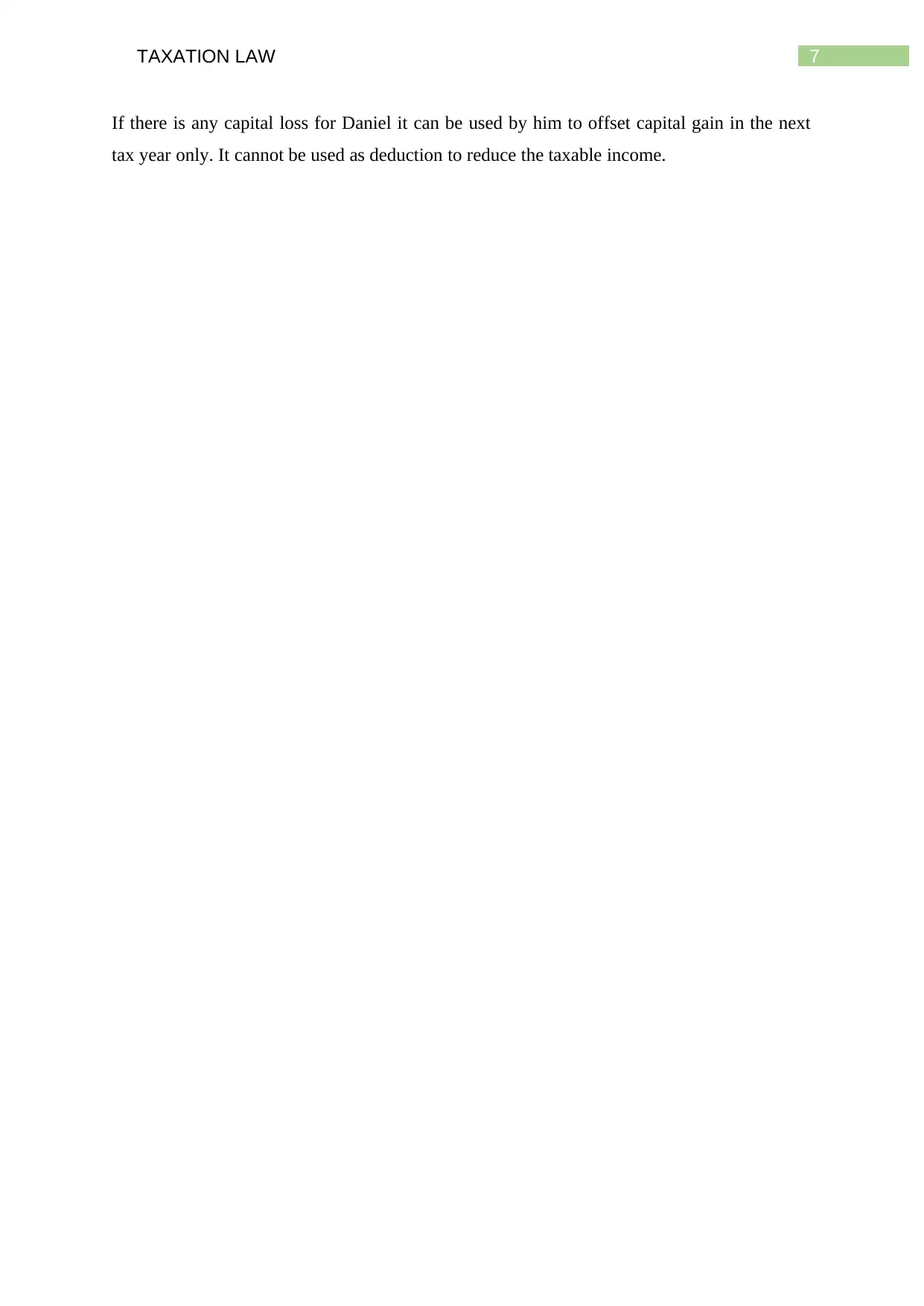
7TAXATION LAW
If there is any capital loss for Daniel it can be used by him to offset capital gain in the next
tax year only. It cannot be used as deduction to reduce the taxable income.
If there is any capital loss for Daniel it can be used by him to offset capital gain in the next
tax year only. It cannot be used as deduction to reduce the taxable income.
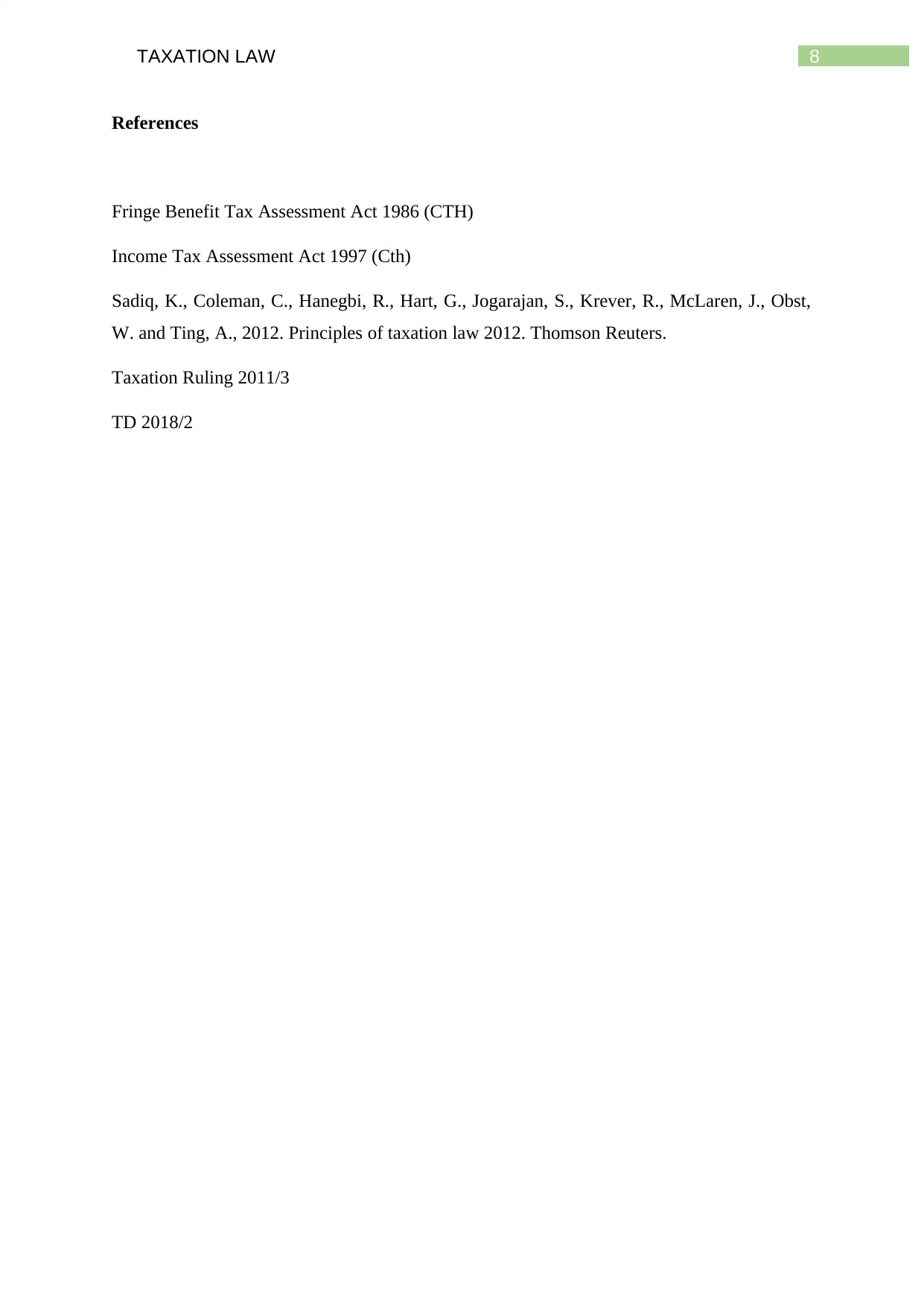
8TAXATION LAW
References
Fringe Benefit Tax Assessment Act 1986 (CTH)
Income Tax Assessment Act 1997 (Cth)
Sadiq, K., Coleman, C., Hanegbi, R., Hart, G., Jogarajan, S., Krever, R., McLaren, J., Obst,
W. and Ting, A., 2012. Principles of taxation law 2012. Thomson Reuters.
Taxation Ruling 2011/3
TD 2018/2
References
Fringe Benefit Tax Assessment Act 1986 (CTH)
Income Tax Assessment Act 1997 (Cth)
Sadiq, K., Coleman, C., Hanegbi, R., Hart, G., Jogarajan, S., Krever, R., McLaren, J., Obst,
W. and Ting, A., 2012. Principles of taxation law 2012. Thomson Reuters.
Taxation Ruling 2011/3
TD 2018/2
⊘ This is a preview!⊘
Do you want full access?
Subscribe today to unlock all pages.

Trusted by 1+ million students worldwide
1 out of 9
Related Documents
Your All-in-One AI-Powered Toolkit for Academic Success.
+13062052269
info@desklib.com
Available 24*7 on WhatsApp / Email
![[object Object]](/_next/static/media/star-bottom.7253800d.svg)
Unlock your academic potential
Copyright © 2020–2025 A2Z Services. All Rights Reserved. Developed and managed by ZUCOL.





